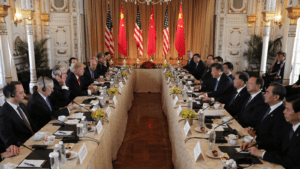
Ruto Highest Earning President Globally
- President Ruto expressed confidence in resolving the challenges with the new Social Health Authority (SHA) scheme.
- The transition from NHIF to SHA, now branded as Taifa Care, aims to provide universal, affordable healthcare to all Kenyans.
- Implementation hurdles, including technological and operational issues, have caused delays and criticism.
- Under SHA, Kenyans contribute 2.75% of their income, with a minimum contribution set at Ksh. 300.
- Over 15 million Kenyans are currently enrolled in the Taifa Care program.
In a bid to address the ongoing concerns surrounding Kenya’s healthcare system, President William Ruto has reiterated his confidence that the teething problems accompanying the transition from the National Health Insurance Fund (NHIF) to the Social Health Authority (SHA) will soon be resolved. Speaking during the 11th National and County Governments Coordinating Summit held at State House, Nairobi, President Ruto emphasized the government’s commitment to ensuring universal healthcare access for all citizens through the newly rebranded Taifa Care program.
A Shift in Strategy: From NHIF to Taifa Care
The Kenyan government’s decision to transition from NHIF to SHA represents a significant shift in the country’s healthcare strategy. The initiative, now operating under the brand name Taifa Care, seeks to provide quality healthcare services to all Kenyans, regardless of their socio-economic status. According to President Ruto, the scale and ambition of Taifa Care are unprecedented, making it one of the most transformative healthcare reforms in the nation’s history.
“Taifa Care is designed to overcome both technological and operational challenges to ensure that every Kenyan, irrespective of their means, has access to affordable, high-quality healthcare,” President Ruto affirmed during the summit. He acknowledged that while the program has encountered initial hurdles, these are expected in a project of such magnitude and complexity.
Operational Challenges and Public Criticism
The rollout of Taifa Care has not been without challenges. Many Kenyans have raised concerns over the program’s limited benefits and difficulties in accessing healthcare services. Since the transition in October, there have been widespread complaints about inefficiencies, including delayed approvals and insufficient communication about how the new system operates.
Critics have also highlighted the financial burden posed by the program. Under the SHA model, citizens are required to contribute 2.75% of their monthly income, with a minimum payment of Ksh. 300. This contribution model, while designed to pool resources and ensure sustainability, has faced resistance from low-income earners who view it as an additional strain on their already limited finances.
Despite these concerns, President Ruto remains steadfast in his belief that the challenges are temporary. He pointed out that the program’s boldness and scope require patience and support from all stakeholders.
Government’s Defense of Taifa Care
Senior government officials, including Health Cabinet Secretary Deborah Barasa, have joined President Ruto in defending the Taifa Care initiative. During public addresses, they have called for understanding from citizens, emphasizing that the program’s long-term benefits far outweigh its initial setbacks.
“Transforming a healthcare system is not a small task,” said CS Barasa. “We are laying the foundation for a robust system that will serve future generations. It requires time, resources, and the collective effort of all Kenyans.”
Enrollment Milestones and Future Prospects
As of November, over 15 million Kenyans have enrolled in Taifa Care, marking a significant milestone in the government’s quest for universal healthcare. President Ruto highlighted this achievement during his State of the Nation address, noting that the high enrollment figures demonstrate public trust in the program’s potential.
However, he acknowledged that enrollment is just the beginning. The real challenge lies in ensuring that the system delivers on its promise of accessible and affordable healthcare. To achieve this, the government has outlined several priority areas, including:
- Enhancing Technological Infrastructure: Addressing issues with digital systems to streamline processes and reduce delays in service delivery.
- Training and Capacity Building: Equipping healthcare workers with the necessary skills to operate within the new framework.
- Public Awareness Campaigns: Educating Kenyans about the benefits of Taifa Care and how to navigate the new system effectively.
- Strengthening Partnerships: Collaborating with county governments, private sector players, and international organizations to bolster the program’s resources and reach.
Balancing Boldness with Realism
President Ruto’s emphasis on the unprecedented scale of Taifa Care underscores the ambitious nature of the initiative. The program aims to address long-standing disparities in healthcare access, which have historically marginalized vulnerable populations. By pooling resources through a mandatory contribution model, the government seeks to create a more equitable system where no one is left behind.
Nevertheless, the transition has revealed the complexities involved in implementing such a comprehensive reform. Critics argue that the government could have done more to anticipate and mitigate these challenges before rolling out the program. For instance, better communication and stakeholder engagement might have alleviated some of the public’s concerns.
A Call for Patience and Collaboration
Acknowledging the growing frustration among citizens, President Ruto has called for patience and collaboration as the government works to refine the system. He emphasized that the success of Taifa Care depends not only on government efforts but also on the active participation of all Kenyans.
“Healthcare is a shared responsibility,” Ruto remarked. “We need everyone—from policymakers to ordinary citizens—to play their part in making Taifa Care a success.”
This sentiment has been echoed by other leaders, who stress the importance of unity in overcoming the program’s initial hurdles. They argue that Taifa Care has the potential to transform Kenya’s healthcare landscape if given the necessary support.
Comparative Insights: Lessons from Global Healthcare Reforms
Kenya’s efforts to implement Taifa Care mirror similar initiatives in other countries that have sought to achieve universal healthcare. For example, nations like Rwanda and Thailand have successfully introduced mandatory health insurance schemes, resulting in significant improvements in health outcomes. These countries’ experiences highlight the importance of phased implementation, robust stakeholder engagement, and continuous monitoring to address emerging challenges.
Learning from these examples, Kenya can adopt a more adaptive approach to refining Taifa Care. Regular feedback mechanisms, inclusive policymaking, and targeted interventions can help ensure the program’s sustainability and effectiveness.
The Road Ahead
Despite the challenges, President Ruto’s optimism signals a determination to see Taifa Care succeed. The program represents a crucial step towards achieving the government’s broader vision of a prosperous and equitable society. By prioritizing healthcare, the administration seeks to empower citizens and enhance their quality of life.
Moving forward, the government must remain transparent and accountable in addressing public concerns. Continuous dialogue with stakeholders, including healthcare providers, community leaders, and citizens, will be essential in building trust and ensuring the program’s long-term viability.


